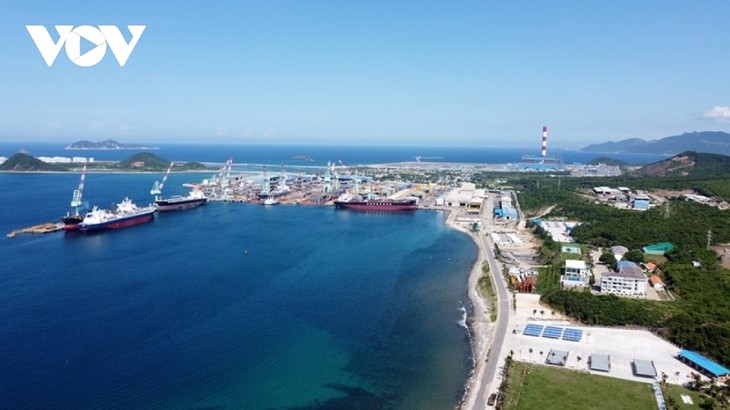(VOVWORLD) - Prime Minister Pham Minh Chinh has highlighted the important role of the marine economy and national maritime space, saying it is a key priority. In his report at the opening of the NA’s ongoing meeting on Monday, Prime Minister Chinh stressed that as the 21st century is regarded as the century of the ocean, the strategy of "Reaching out to sea" has emerged as a crucial direction for coastal nations, including Vietnam.
 Van Phong Economic Zone in Khanh Hoa province (photo: VOV) Van Phong Economic Zone in Khanh Hoa province (photo: VOV) |
Currently, about 19 million people reside in 28 coastal provinces and cities, accounting for over half of these localities’ population. Nearly half of Vietnam's major urban centers are located in coastal areas and islands.
Changes from localities
Khanh Hoa province in the south-central coastal region aims to become an international hub for marine tourism and services by 2030 and a growth driver of the marine economy in the central coastal region, the Central Highlands, and the whole country. By 2050, it envisions itself as a major marine economic center and a smart, environmentally friendly city of regional stature. To leverage its marine economy, the province is focusing on high-quality logistics services, processing and manufacturing industries, and energy development.
Nguyen Tan Tuan, Chairman of the Khanh Hoa provincial People's Committee, said: "The province is developing plans to become a regional marine urban area while maintaining national defense and security and maritime sovereignty. Truong Sa island district is at the strategic location. We aim to develop the district to protect maritime sovereignty and promote economic growth."
Ben Tre province, which has a 65km coastline, has promoted its Eastward Strategy over the past four years. The province is implementing 19 wind power projects with a total capacity exceeding 1,000 MW, nine of which have completed construction and installation and are now providing 365 MW of power. The provincial People’s Committee has submitted a proposal to the Prime Minister for the "Ben Tre Green Hydrogen Complex" pilot project, aimed at spearheading Vietnam’s hydrogen production industry.
As part of its Eastward Strategy, Ben Tre is encouraging investment in its ambitious sea encroachment project.
Tran Ngoc Tam, Chairman of the Ben Tre provincial People’s Committee, said: "We aim to develop to the east and seek to encroach upon 50,000 hectares of sea. This reflects Ben Tre province’s aspiration to create development breakthroughs. We really hope to attract investment in this effort and through investors Ben Tre province will thrive."
Key directions for Vietnam's marine economy
Vietnam currently has 19 coastal economic zones in its approved development plan, 18 of which have already been established and have attracted 550 foreign projects with a total registered investment of nearly 55 billion USD. An additional 1,600 domestic projects have attracted registered capital of more than 58 billion USD. In 2022, the GDP of Vietnam’s 28 coastal provinces accounted for 49% of the nation's GDP.
Vietnam has made significant strides in refining its policies, laws, and strategies for marine economic development. In 2018, the Party Central Committee issued Resolution 36 on the Strategy for Vietnam Marine Economy Sustainable Development until 2030, with a vision to 2045. The National Assembly adopted the 2012 Law on the Sea of Vietnam and the 2015 Law on Marine and Island Resources and Environment. In June 2024, the National Assembly approved the Resolution on National Marine Spatial Planning for 2021-2030, with a vision to 2050.
 Minister of Planning and Investment Nguyen Chi Dung (Photo: nld.vn) Minister of Planning and Investment Nguyen Chi Dung (Photo: nld.vn) |
Minister of Planning and Investment Nguyen Chi Dung said the State has invested a great deal in coastal areas and marine projects and established a marine economic corridor.
Minister Dung suggested ways to sustainably develop the marine economy and national maritime space.
Dung said: "In the near future, ministries and sectors need to review national, regional, sectoral, and provincial master plans, ensuring they align with three core principles: developing an economy aligned with national defense; focusing on key priority projects; and promoting key industries and growth drivers such as renewable energy, shipping, and logistics."
The Resolution of the 8th Plenum of the 12th Party Central Committee on the Strategy for Vietnam Marine Economy Sustainable Development until 2030, with a vision to 2045, declared that Vietnam must become a strong, prosperous maritime nation, with sustainable development, prosperity, security, safety, and sustainable economic growth closely aligned with national defense, security, sovereignty, and territorial integrity.
Vietnam is at a pivotal juncture, with numerous opportunities to accelerate progress to realize its 2024 and 2025 goals and the broader 2021-2025 plan. Reaching out to the sea and sustainably developing the marine economy will be critical for Vietnam to achieve its long-term development goals.